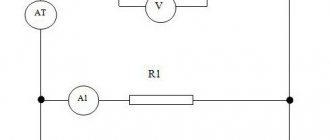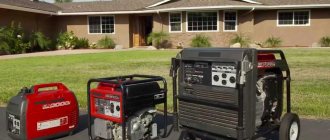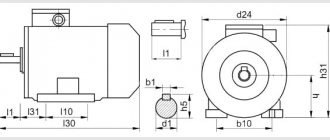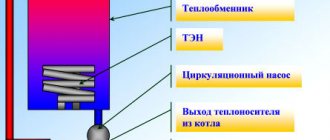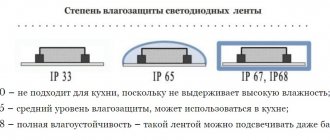Despite the fact that the global market for distributed energy resource technologies is growing at a rate of about 6-9% per year, solar and wind generation are actively developing, diesel power plants - the so-called “classic of Soviet energy”.
And this is understandable: until now, more than half of the territory of our country does not have a centralized energy supply; tens of thousands of settlements are provided with electricity through diesel power plants. In this review, we will try to understand what a diesel power plant is, what tasks it is suitable for, what advantages and disadvantages it has, and what is the secret of its undying popularity.
What is a diesel power plant?
So, the abbreviation “DES” (diesel power plant) refers to a stationary or mobile power plant consisting of two main elements: an electric generator and an internal combustion engine running on diesel fuel. United by a common frame, these elements complement each other and provide the process of changing one type of energy into another.
It should be taken into account that the terms “diesel power plant”, “diesel-electric unit”, “diesel generator” are not identical definitions. These concepts have significant differences:
Diesel generator is a device consisting of a technologically integrated diesel engine and generator;
Diesel-electric unit - a device that includes a diesel generator, as well as auxiliary devices (frame, control devices, fuel tank);
A diesel power plant is a full-fledged power plant, which includes, in addition to a diesel-electric unit, many other important elements: a device for distributing electricity, automation cabinets, a control panel, etc. It is a diesel power plant that allows you to provide the consumer with electricity of the required quality and in the required volume. And in fact, this makes this area of autonomous energy one of the most popular and popular in remote areas of our country.
Types of diesel generator sets by type of control
Diesel power plants have different levels of automation: from the simplest manual units to “smart” units with remote control.
- Manually controlled diesel engines are started and turned off by pressing a button. They are easy to use and at the same time equipped with basic control functionality. The disadvantage of manually started units is the need for constant operator presence.
- Diesel generator sets with automatic backup switch on automatically when the power supply to the network is interrupted and stop when power is restored. The range of features depends on the characteristics of a particular model. Some functions require operator participation. Automated diesel power plants are optimal for organizing backup power supply to facilities.
- Diesel power plants with remote control using a computer are the most advanced type of diesel generator set. Such installations allow you to control the power supply of several objects from one remote control. They are used in complex branched power supply systems.
Operating principle of diesel power plant
The operating principle of a diesel power plant is to convert mechanical energy into electrical energy. The following key stages can be distinguished:
- Air is supplied to the engine cylinders, where it is compressed and heated to high limits. Then diesel fuel enters the working chamber under pressure and ignites.
- The gases formed as a result of combustion start the engine into operation. The crankshaft begins to rotate, setting the rotor of the electric generator in motion.
- When the generator rotor rotates, it excites an electromagnetic field, which, in turn, creates an inductive alternating current in the generator winding, which converts into electrical energy at the output.
Budget
This category presents products from Russian and Chinese manufacturers. The approximate cost of a 300 kW diesel generator set in an open version is 1.2–1.5 million rubles. Chinese-made diesel power plants produced under the brands
- Shandong,
- Shanghai Diesel,
- Ricardo,
- Yuchai,
- Kipor,
They are mainly clones of models from well-known manufacturers. Despite the desire to match the originals, they are still significantly inferior in quality and reliability to American and European models.
The balance of favorable prices and optimal technical characteristics is represented by Russian-made diesel power plants. Comparable in cost to Chinese units, they are reliable, practical, easy to operate and repair. Domestic diesel power plants are adapted to Russian operating conditions, which cannot be said about imported generators.
Areas of application of diesel power plants
Diesel power plants are most actively used in areas where there is no centralized power supply, or there are certain difficulties with the supply of electricity. Typically this is:
- small settlements located in remote and Arctic territories;
- agricultural enterprises (farms, state farms), as well as holiday villages and gardening partnerships located on the periphery;
- production facilities where oil, gas and other natural resources are extracted, located in hard-to-reach places.
It is there that diesel power plants may be the only possible source of electricity. It should be taken into account that diesel power plants can also perform auxiliary functions:
- a backup source of electricity when diesel power plants only supplement the main sources of power supply - centralized networks;
- emergency source of electricity, when diesel power plants are installed at large enterprises in order to protect consumers from possible accidents and organize uninterrupted power supply.
Business
The middle price segment is occupied by Turkish-assembled diesel power plants, supplied to the market under the brands
- AKSA,
- Teksan.
Their cost is about 2 million rubles.
Somewhat more expensive, but also within this category - European-made units
- SDMO,
- Gesan.
These diesel power plants are manufactured using components from the world's leading manufacturers -
- Cummins,
- Perkins,
- Volvo Penta,
- Mitsubishi,
- Doosan.
They differ from premium units only in the country of assembly.
Types of diesel power plants
There are several classifications of modern diesel power plants.
Depending on the purpose, diesel power plants are distinguished:
- mobile – used as a portable or backup source of power supply;
- stationary – integrated into a unified energy complex system.
Depending on the design content, diesel power plants are distinguished:
- open – not protected by anything, can only be located in a specially equipped room;
- in a noise-proof casing – the casing reduces the noise level, which allows the use of these power plants in populated areas;
- container - for additional protection and noise reduction, it is placed in a special container or block module.
Depending on the number of phases generated by the equipment, diesel power plants are distinguished:
- single-phase – produce a voltage of 220 Volts
- three-phase - produce from 220 to 400 Volts.
Depending on the type of voltage, diesel power plants are distinguished:
- low voltage (up to 1 kW)
- high voltage (over 1 kW).
Typical design of diesel fuel installations
Structurally, all diesel generators belong to the category of multi-purpose devices with internal combustion engines. The stations are produced in two types, providing for fixed and mobile use, depending on operating conditions.
Almost all diesel power plants are a fairly complex mechanism assembled from various parts and components.
The main components of the DES are:
- Four-stroke diesel engine. The number of cylinders ranges from 1 to 8 and corresponds to the declared performance of the unit.
- Fuel system and air injection equipment. The mixture components enter the engine separately. Diesel fuel is sprayed into the cylinder through nozzles by a fuel pump, and air is pumped by a turbocharger. Under the influence of pressure, the air is strongly heated, igniting the atomized fuel.
- A cooling system that removes excess heat from heated parts and maintains the required temperature level. The coolant is water or antifreeze. Its movement inside the water jacket occurs through special channels, under pressure created by the water pump. At the end of the complete cycle, the coolant returns to the radiator tank and reduces the temperature under the action of the fan blades.
- Generator set. Produces electric current and, depending on the modification, can be single-phase (220 V) or 3-phase (380 V and above) type.
- Automatic control system. Better known as the automatic reserve entry system. This equipment automatically turns on the generator without operator intervention.
- Fuel tank. A fairly spacious tank with a volume of 200-300 liters.
- Frame. Metal frame on which all components and parts are placed. Damper pads are installed at the fastening points to provide protection against vibration vibrations.
- Container capacity, also known as casing. Installed on top of the entire structure, it protects the station from external negative influences. Reduces the noise level produced during operation.
Mobile diesel power plants
In this review, we will separately focus on such a variety of modern diesel power plants as mobile (or mobile) diesel power plants. Its main purpose is to generate electricity in the most inaccessible places with the ability to quickly change its location. Mobile diesel power plants are actively used in the mining industry (for example, in various natural resource deposits), in the construction industry (in the construction of roads and the construction of remote settlements), in agriculture (on remote land), as well as to meet the needs of private consumers.
There are a lot of options for manufacturing mobile diesel power plants. The most popular are mobile diesel power plants on their own self-propelled chassis; adapted for installation on a car body; having a body similar to a “trailer”.
As a rule, mobile diesel power stations are manufactured in a special durable container that protects the device from adverse weather conditions (rain) and mechanical damage. The main advantage of a mobile diesel power plant is a high degree of mobility, maximum ease of maintenance, and use of the power plant immediately after purchase.
Pros and cons of diesel power plants
Diesel power plants, of course, have their own significant advantages, making this area of autonomous power supply popular for many years. Among the main advantages are the following:
- high degree of mobility and portability;
- ease of installation and construction.
However, there are also significant disadvantages of diesel power plants, which every year are gradually “displacing” diesel power plants from their leading positions, including in remote and Arctic territories of the country. Among the main disadvantages we name the following:
- low degree of reliability (diesel power plants often fail, the accident rate is quite high);
- low degree of environmental friendliness (diesel power plants are considered one of the most environmentally “dirty” sources of energy supply, which is why all diesel power plants are carefully checked for compliance with international standards and norms, otherwise large fines cannot be avoided);
- the need for constant maintenance (diesel power plants need constant inspection by experienced engineers to minimize the number of accidents);
- limited selection of domestic diesel generators (the most reliable are foreign diesel generators from brands such as Cummins, NeuHaus, Wilson, Aksa - but their cost is significantly higher than their Russian counterparts).
Maintenance and operating recommendations
With constant and long-term use of installations, it is necessary to comply with the rules of technical operation of diesel power plants. Maintenance is carried out by specially trained personnel. Persons authorized to use stations must be well aware of the principles of their operation, design differences and features, and the potential capabilities of control systems.
From time to time, all employees performing maintenance of diesel power plants are required to pass exams on job descriptions, labor protection and safe use of installations. Based on the results of the exams, a certificate is issued allowing work as a power plant operator.
When performing maintenance on diesel stations, the following actions are performed:
- Before starting the engine, an external inspection of the installation is carried out in accordance with the technical specifications. Protective screens are installed on all moving parts. The device must be free of visible damage and leaks of fuel and lubricants. The engine oil is preheated to 35 degrees. This makes starting easier and increases service life.
- After switching to operating mode, you need to regularly monitor the oil level in the lubrication system. The permissible natural loss is 100 g for every 100 hours worked by the unit.
- The components are regularly cleaned of dust and dirt accumulated over the past period, oil traces and drips are removed. Thus, the power plant does not overheat and its service life is extended.
- The load should be controlled so that the number of consumers does not exceed the rated power of the generator. For this reason, the generator set most often becomes overloaded and stops working normally, even to a complete stop. Working without load for more than 30 minutes also negatively affects the life of parts, causing their premature wear.
- In case of forced downtime of the generator for a long time, it is recommended to start it at least once a month for 1 hour.


